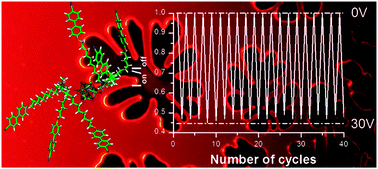Electroswitchable red-NIR luminescence of ionic clustomesogen containing nematic liquid crystalline devices†
Abstract
We describe in this work several polyionic hybrid molecular compounds combining, by electrostatic interactions, liquid crystalline ammonium cations and tailor made molybdenum hexanuclear dianionic cluster units. All hybrids show nematic liquid crystalline behaviour below 100 °C, no matter the nature of the metallic cluster apical and inner ligands. They also retain the shiny deep red photoluminescence properties of their parent cluster in the nematic phase. This nematic phase remains however quite viscous for all compounds and mixing them with commercially available nematic LCs seems mandatory to integrate them into electroswitchable devices. This particularity conducted us to insert the best candidate in terms of homogeneity and stability of the clustomesogen/commercial LC mixture into a LC cell and study the behaviour toward the application of an electric stimulus. We show that the application of 30 V AC voltage allows observing a reversible modulation of the photoluminescence signal by about 52%. This work presents the first deep red photoluminescent transition metal cluster containing device directed towards optoelectronic applications.


 Please wait while we load your content...
Please wait while we load your content...